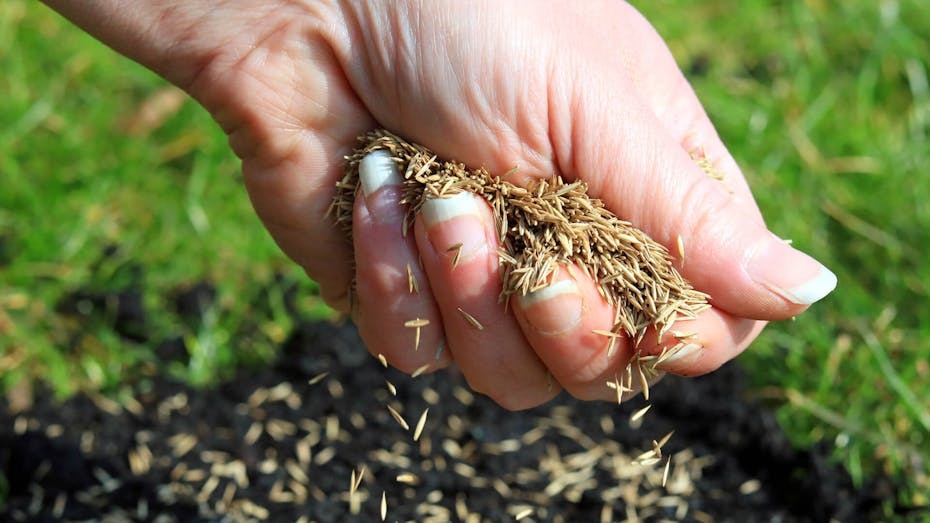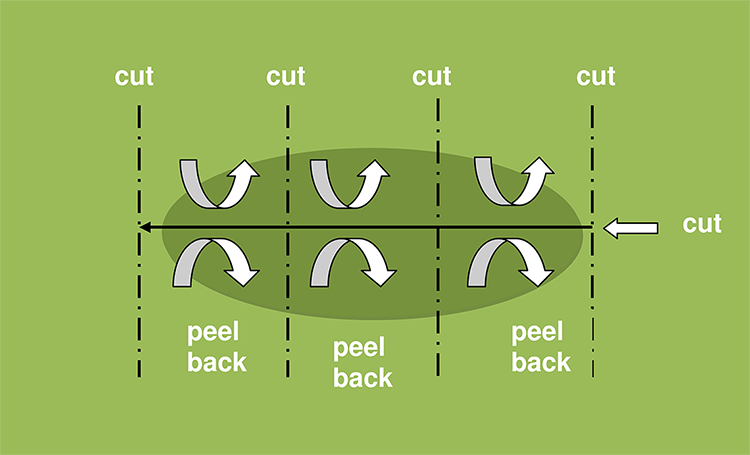
Repairing the Lawn
Worn patches of lawn, hollows, mole hills, fairy rings, shade and tree roots: a few simple techniques and a handful of lawn grass seed can make all the difference
Lawn repairs are generally for isolated areas of lawn where the rest of the lawn is satisfactory.
Whether or not you are pro-active with your lawn care you should be aware of three very important facts:
- Grass has phenomenal recuperative powers and in the right conditions lawns can quickly repair themselves
- Weeds and weed grasses are survival experts and will often colonise damaged areas before your lawn can repair itself
- Dead grass or no grass cannot repair itself!
Therefore, always repair lawn damage at the earliest opportunity. One of the best things you can do is always have some grass seed on hand as a light scattering on damaged areas can often mean grass instead of weeds. Some of the reasons a lawn repair may be required are:
Worn or compacted areas due to excessive use: See Localised Lawn Aeration and always over seed
Thin or depleted grass cover caused by overhanging trees and bushes: Prick the area with a fork or score the surface with a rake, sprinkle in the right amount and type of seed, tread to firm the surface and keep watered to prevent from drying out. Can be done from April to September.
Heavily Shaded Areas: Some areas of a lawn are so shady that the grass becomes very thin over a summer or winter season. Grass won’t survive in permanent shade so you should either replace the grass with a plant that will survive or over seed the area every spring. If taking the latter option, seed as early as possible (late March to early April) well before the leaves come on the trees. This way the young grass shoots will get maximum light and establish well before the light levels fall.
Areas that suffer premature drying: This may be caused by localised compaction, trees or a fungal disease in the soil known as ‘dry patch’. Open the soil up or take a sample from the affected area and if you see white specks then it’s a fungal disease. Quite often adding a wetting agent to areas that prematurely dry can aid water penetration and improve the water holding capacity of the soil.
For more advice read Dry Patch in Pests & Diseases and Localised Lawn Aeration
Bumps and Hollows: Very slight undulations can be solved with Top Dressing but anything more than 1/2″ needs a different procedure.

Small ones can be sorted by slicing into the turf with a spade all along the length of the bump or hollow 1” to 2” deep. Then do the same at right angles. Next push the spade underneath the turf to cut the grass roots so that the turf can be peeled back in strips. Finally, remove or add soil, firm by treading, then fold back the turf and tamp down with the spade. If adding soil try and use soil from the borders or at least a similar soil to that in the lawn.
Larger bumps and hollows require the turf to be removed completely, soil added or removed then re-turfed or seeded. You will find new turf is considerably easier to lay than your removed turf but it may be difficult to match. Seeding the area may offer a better grass match.
CAUTION: Do not fill hollows by putting soil on top of the lawn then re-seeding or turfing. The area will dry rapidly and may well not survive. Remove the old lawn first.
Damage from tree roots: As tree roots grow they thicken often forcing the lawn surface up or even becoming exposed themselves. If the problem is minor then light and frequent top dressings to build up the lawn surface to cover the root should do the trick. See Top Dressing
For more severe problems splicing open the turf, folding and rolling it back and removing the root may be required. As this may impact on the health of the tree consulting with a Tree Surgeon would be wise. Once removed, the empty space should then be filled with similar soil (take some from the borders if possible), firm by treading and then the turf rolled back into place and tamp down with the spade.
Urine damage from pets or foxes: Rake out the dead grass making sure the soil is well scored. Sprinkle in 10 seeds per inch, tread to firm and keep from drying out by frequent light watering.
Mole Hills and Fairy Rings: See Pests & Diseases
Mowing after repairs should be as normal for an established lawn. Sharp blades are beneficial.
Always keep renovated areas well watered for several weeks to aid recovery.